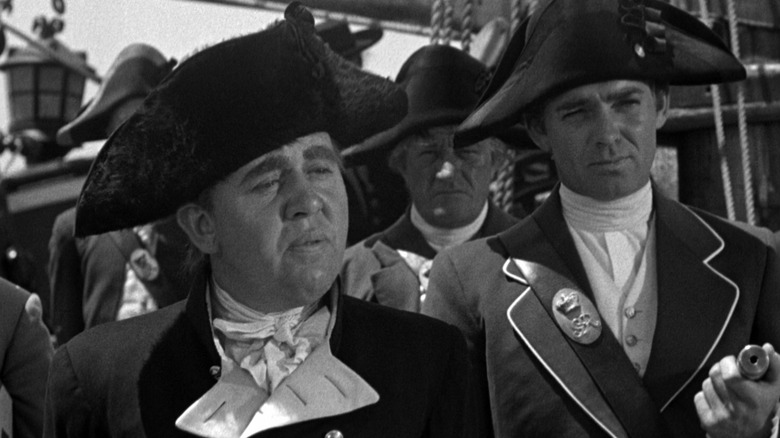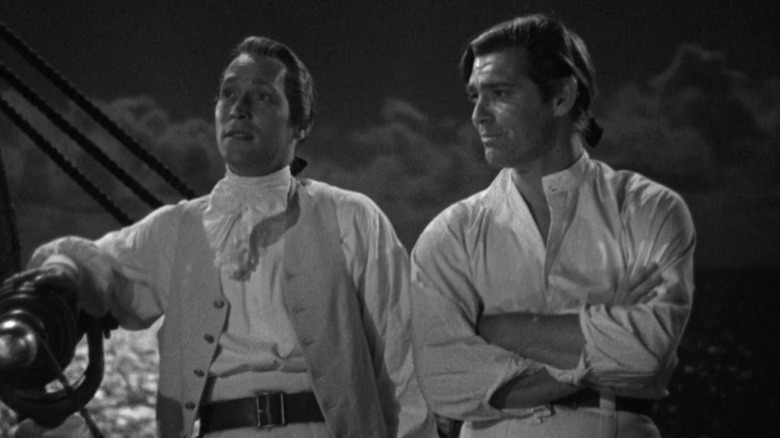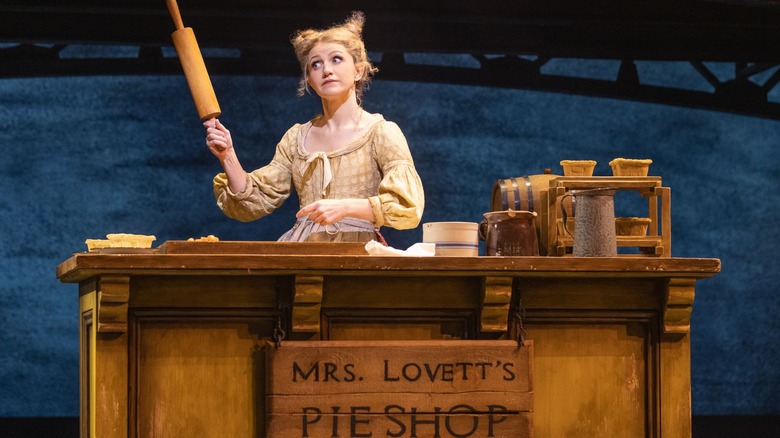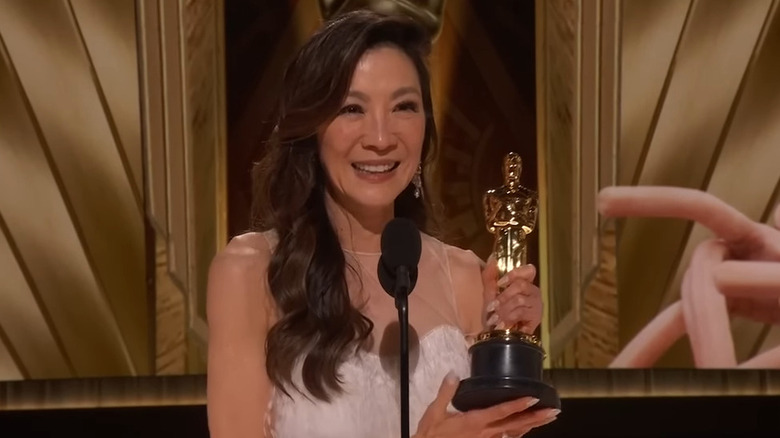A Hollywood Classic Raises A Big Question: Are Supporting Acting Categories Even Necessary?
(Welcome to Did They Get It Right?, a series where we look at an Oscars category from yesteryear and examine whether the Academy's winner stands the test of time.)
We are in somewhat of a transitional period with how we think about the acting categories for entertainment awards. This, primarily, has to do with gender. We have had separate categories for female and male performers for decades upon decades, but if you really stop to think about it, there is no difference in what a female actor does compared to a male one. Why shouldn't Colin Farrell in "The Banshees of Inisherin" compete against Cate Blanchett in "TÁR"? Of course, the worry is that in our patriarchal society, men will come to dominate that category and fewer women will be nominated and win. Then you have the added issue of non-binary performers being forced to slot themselves in a particular gendered category that doesn't align with who they actually are or, in some cases, just pulling themselves out of awards contention altogether.
At the Oscars, the gendered acting categories have always been in place, but there was a big change in them within their first decade. For the first eight years of the Oscars, the only two acting categories were Best Actor and Best Actress. The supporting races didn't exist. This came to a head with 1935's "Mutiny on the Bounty," which scored three of the four Best Actor nominations that year for Charles Laughton, Clark Gable, and Franchot Tone. To this day, it remains the only film to receive three Best Actor nominations. Its monopolization of the category spurred the Academy to add the supporting races the following year, but in our age of consolidating the categories, I wonder if breaking them apart was a necessary decision.
How did supporting actors fare before the new categories?
The Academy Awards were created at a time when the star system was really taking hold in Hollywood. Most films produced by the major studios — which were basically the only things the Academy cared about — were designed to be vehicles for those stars, be it Janet Gaynor, Norma Shearer, Emil Jannings, Fredric March, or Greta Garbo. They were the attractions and had their names prominently placed above the titles of their movies. The construction of the films was also engineered to serve those stars. Sure, they'd sometimes be given a co-lead, which would usually be in the form of a romantic counterpart, but then it would be a two movie star movie, rather than just one. The supporting players in a film were the tried-and-true "character actors," those plug-and-play performers that could appear in half a dozen or so movies in a year to serve the stars at their centers.
Consequently, supporting actors basically never made it into the Best Actor category during those first seven years of the Oscars. If you look at every nominee from that time, you will almost never find an actor who wasn't first or second-billed on the movie. The rare exception would be Lionel Barrymore in 1931's "A Free Soul," who actually took home the Best Actor prize at the 4th Oscars. Playing an alcoholic lawyer, Barrymore gives a fiery performance with a classic climactic courtroom monologue that kills. Supporting actors rarely got a big scene like that, where they get to take over the movie from the stars for an important stretch.
These actors were in a bind. They were ignored for not being stars, but that also meant they couldn't get parts "worthy" of awards recognition. Then came "Mutiny on the Bounty."
Three's a crowd
It's extremely rare that multiple people from the same film are nominated for Best Actor. Only a dozen instances of it have occurred in the Academy's 95-year history, with the most recent being nearly 40 years ago when F. Murray Abraham and Tom Hulce both were nominated for "Amadeus." "Mutiny on the Bounty" was actually the first film to ever get more than one nomination for Best Actor, and it got three, which hasn't been repeated. The Best Picture winner scored nominations for Charles Laughton as the tyrannical Captain William Bligh and Clark Gable as the mutineer Lieutenant Fletcher Christian, the men who had won the previous two Best Actor statues. "Mutiny on the Bounty" is a battle between those two opposing forces. The film got that third nomination, though, which went to Franchot Tone for playing Byam, a midshipman off on his own side plot for most of the movie. He isn't even a part of the titular mutiny.
This nomination caused a number of stirs. For one, Tone was far from the star quality of Gable and Laughton, and placing him alongside those names was raising him to a status I don't think a lot of people felt he deserved. Additionally, the Oscars didn't have a firm number of nominees for the category like they do now. One year could be three. Another could be eight. The year of "Mutiny on the Bounty" only had four, with the other nominee and eventual winner being Victor McLaglen for "The Informer." Not only was Tone taking the place of perhaps a bigger star that could've been nominated that year, but he also made it more difficult for someone from "Mutiny on the Bounty" to actually win. A year later, Best Supporting Actor and Actress were introduced to combat this takeover.
Isn't acting just acting?
The first recipient of the Best Supporting Actor Oscar was Walter Brennan for "Come and Get It" the following year, and Brennan would go on to be the king of that category, winning again two years later for "Kentucky" and two years after that for "The Westerner." You would think someone in their mid-40s becoming a three-time Oscar winner over the course of five years would propel them to get bigger roles and start operating in the leading actor sphere. That didn't happen. Brennan not only was never nominated for Best Actor, but he almost never had an opportunity to even lead a film.
The film business has very narrow ideas about the kinds of people who lead movies. Yes, they need to be charismatic, interesting performers, but they also need to be within the body of someone deemed to be a conventionally attractive person. Sometimes they just trot out a pretty person to be a lead and hope it works. A character actor being able to make it to lead status requires them to be universally accepted as one of the most titanic performers working, like a Charles Laughton or a Philip Seymour Hoffman.
The solution they settled on was to create the supporting categories, but shouldn't it be incumbent on the members of the Academy to expand what they deem to be an award-worthy performance? On the one hand, these supporting players finally got their due. On the other, they were siloed off from the more glamorous, star-driven work of the leading players. A performance is a performance, after all, and an actor can deliver spellbinding work whether they're in every scene or just one. As the old saying goes: there are no small parts, just small actors.
Eliminating category fraud
A major reason I wonder about the necessity of the supporting acting categories involves one of my least favorite elements of awards season: category fraud. As the Oscars evolved and became more and more an exercise in campaigning and strategy, no other category has had more work done on it that Best Supporting Actor and Actress. With every other category at the awards, the eligibility for what and who gets nominated is exceedingly clear. You aren't going to nominate a film's production designer for Best Sound or its editor for Best Cinematography. Meanwhile, these supporting actor races become flexible.
In an effort to better position their contenders for nominations and wins, a studio will deliberately campaign an actor for a category they should not be in, and by and large, the Academy just accepts this. There are so many instances of a film's lead being nominated for supporting that it has basically become an accepted practice at this point. We even hear about discussions six months out from the awards about how an actor will be positioned. From Al Pacino in "The Godfather" to LaKeith Stanfield in "Judas and the Black Messiah" to Jamie Foxx in "Collateral," the supporting categories are rife with nominations for leading roles.
If the goal of creating the supporting categories was to keep a supporting performance like Franchot Tone out of Best Actor, should there not also be an effort to keep leading roles out of supporting? If we were to eliminate that delineation, there would be no questioning of category placement. All actors would be placed up against all other actors, and then it would just be a matter of campaigning the performance itself. Awards strategists would need to rethink campaign strategies, but they honestly should be rethinking that anyway.
Other ways to award performances
Most awards bodies have defaulted to splitting up the lead and supporting categories. Even with shows like the Independent Spirit Awards eliminating gendered categories, they still have that delineation. Some bodies, such as the New York Film Critics Circle, held out on the practice for a long time, but 35 years into their existence, they gave in and started the split. The one awards group that has resisted splintering categories since its very first awards show back in 1935 comes from the world of theatre. That would be the Drama League and their Distinguished Performance Award, which went to Annaleigh Ashford last year for "Sweeney Todd: The Demon Barber of Fleet Street."
Every year, there are dozens of performances nominated for the award. It doesn't matter the size of the role, the gender of the performer, or whether it is an on or off-Broadway production. Then, they select one winner out of those several dozen nominees. As there are more actors for a film than in any other position, it makes sense it would have the largest nomination pool to choose from. Not only could you have the aforementioned Colin Farrell in "The Banshees of Inisherin" up against Cate Blanchett in "TÁR," but they'd be duking it out against Ke Huy Quan for "Everything Everywhere All at Once," Angela Bassett in "Black Panther: Wakanda Forever," and a bunch of people would didn't make the cut at last year's Oscars too.
I wouldn't keep the Drama League's rule that once you win you can't be nominated again, but I think this would make for an exciting, fascinating change to the Oscars that could help open up who gets nominated.
They want actors on stage
The Academy created the Best Supporting Actor and Actress categories after "Mutiny on the Bounty" because they didn't want supporting performances crowding the categories dominated by Hollywood's biggest stars. As the business has evolved, those supporting races have become a place for big-name talent playing co-leads or major supporting roles, and they have become nearly as star-studded as the lead acting categories.
More than just about anything, the Academy is concerned about one thing: ratings, and to them, one of the best ways to get eyeballs on the screen is to parade a line of famous faces onto the stage, to the point where they even experimented with taking categories off the broadcast simply because no famous people would be making a speech. Part of the reason they will kick the can down the road on eliminating the gendered acting categories is that it would reduce the number of acting winners from four to two, halving the speech time for the celebrities. If they took my far more drastic suggestion, just one fame-o would be making a speech.
While eliminating the distinction between lead and supporting would be more accurate to the actual profession, the Academy is making a television show, and adherence to a principle isn't exactly a priority when it comes to doing that. After "Mutiny on the Bounty," the toothpaste came out of the tube, and now, I don't know if there's a way to put it back in. Well, there is, but it would upset quite a lot of people. The acting branch is the largest branch of the Academy. They are the ones who drive the audience. They are going to keep getting their Oscars, even if there doesn't need to be four given out every year.






